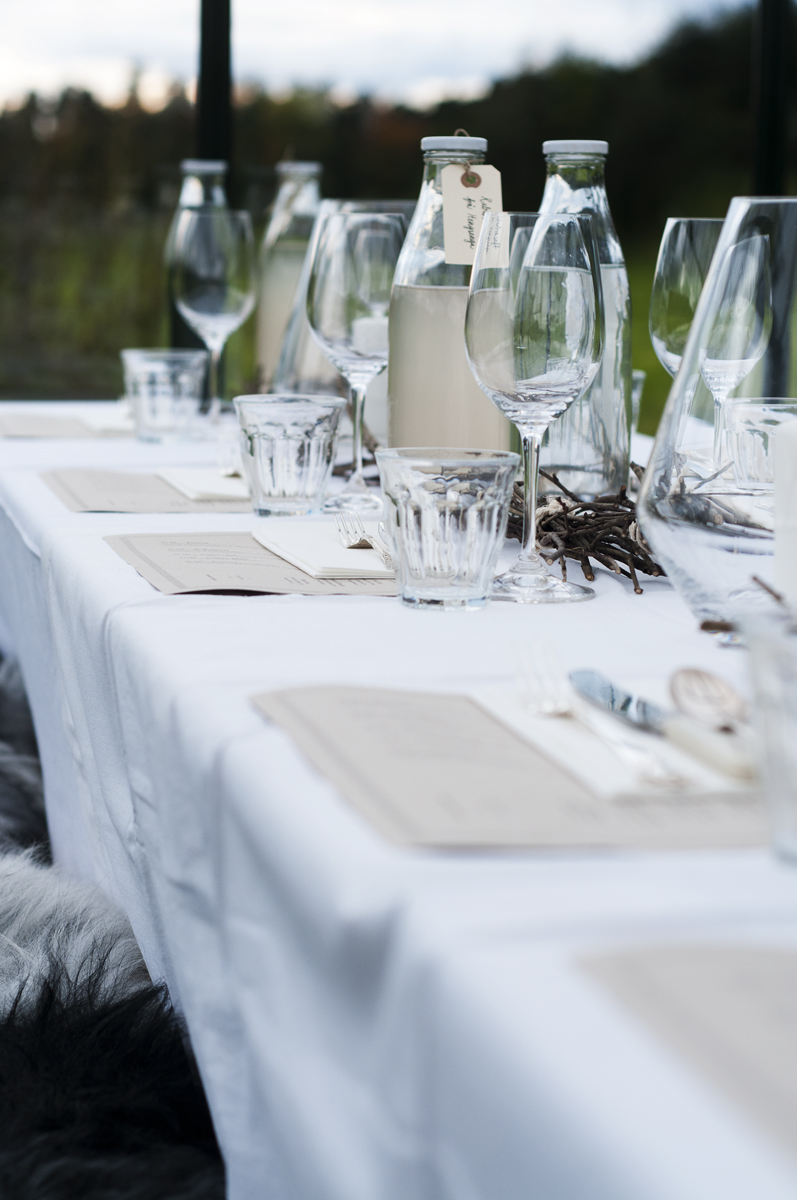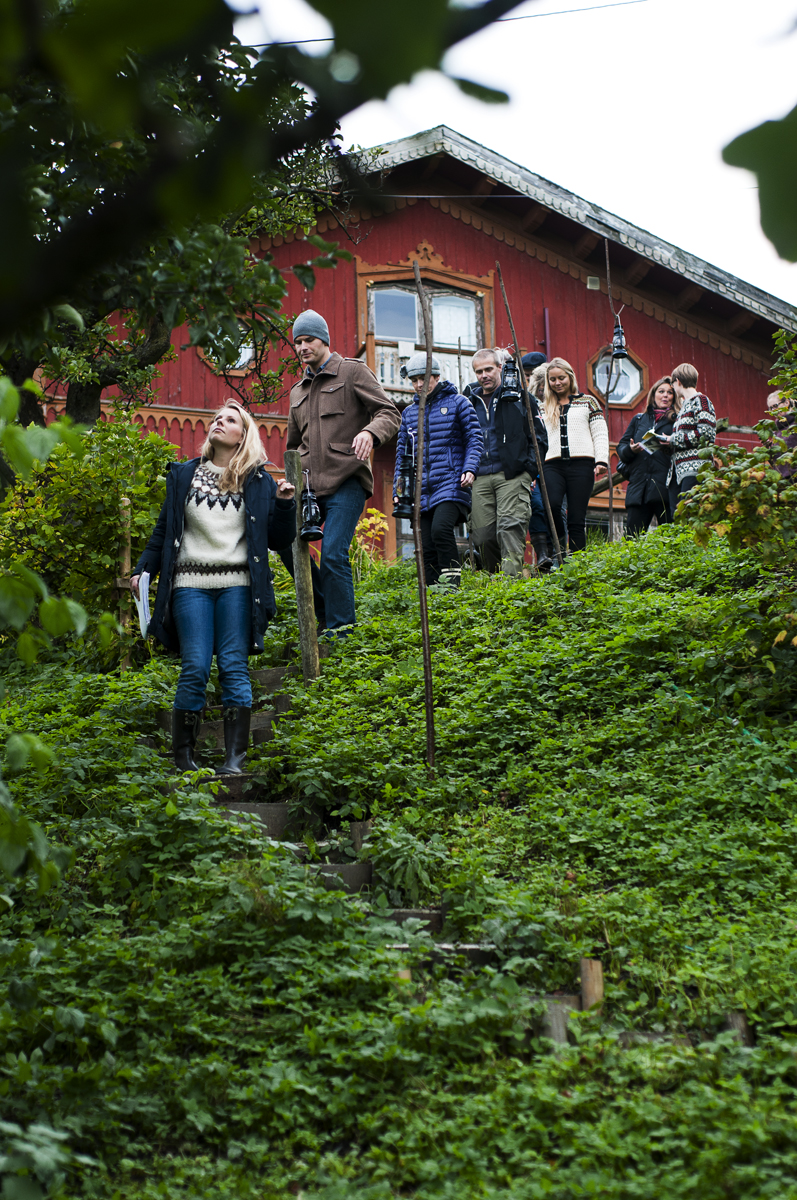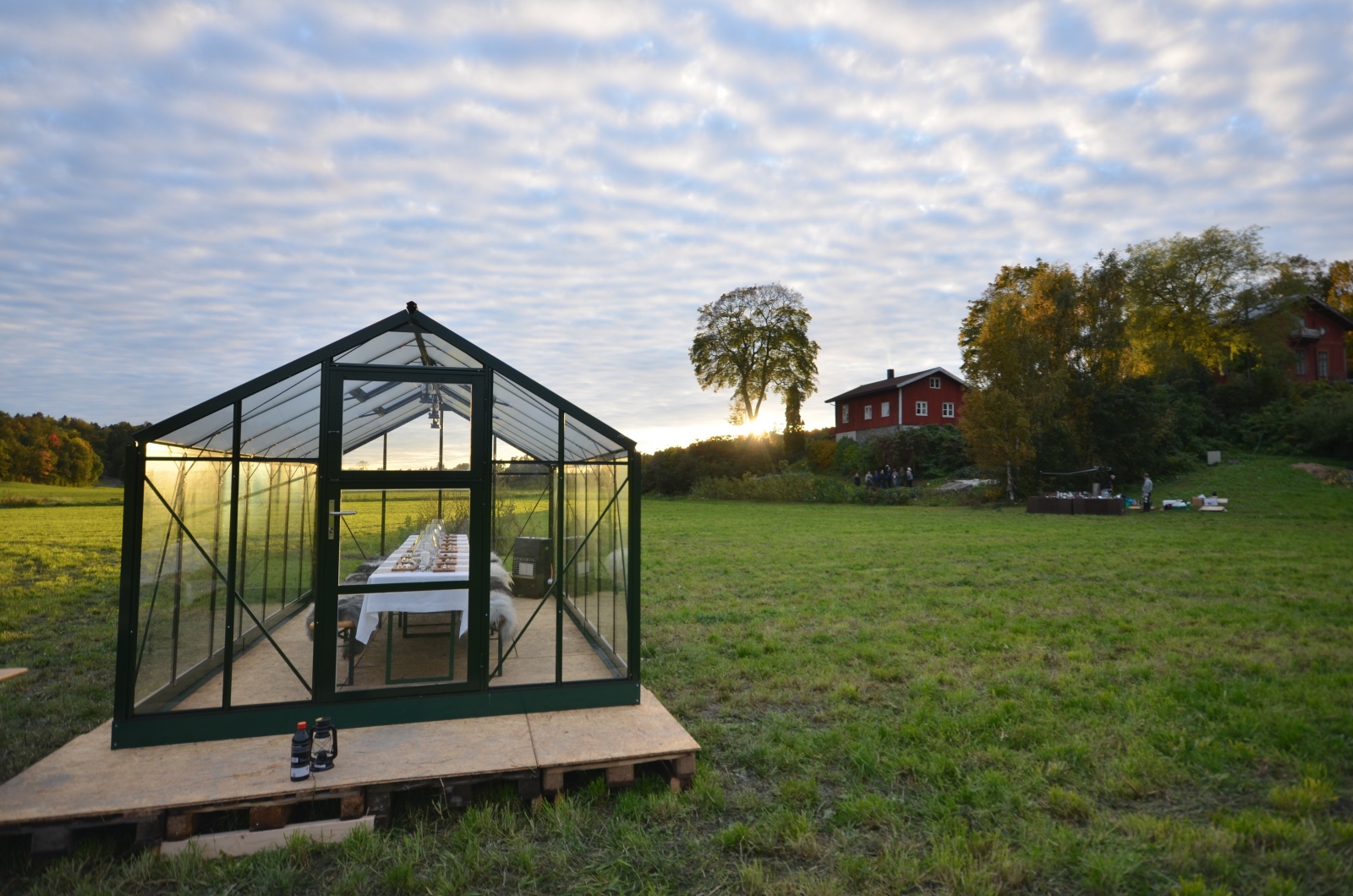Recipe
Field dinner Hengsenga
— A taste of the harvest
This time the scene was set in the middle of a field, only meters away from where the vegetables for the dinner were harvested. The whole meal was focused around self-caught and foraged produce.
This physical proximity to the origin of the food created a unique sense of closeness to what we were eating, a feeling that is unfortunately rare these days.
The menu for the evenings:
- Pickled mussels with egg, seaweed and green beans
- Brussels sprouts with bacon and parsnips
- Pumpkin gnocchi with funnel chanterelles and browned butter
- Fish cakes with Jerusalem artichokes -Goose with cabbage rolls and beetroots
- Smoked apples with cream and oatmeal
Servings: 4
Moestue Grape Selections and their sommelier Torstein Hiorth Østenstad suggested wine pairings for the meal. They provided an interesting combination of biodynamic wines, cider and beer from like minded producers like Bøgedal in Denmark.
Pickled mussels with egg, seaweed and green beans
On our walk around the garden, we stumbled upon the chef, Magne, who was busy harvesting green beans for the dinner later that same evening. This was certainly locally produced and freshly harvested green beans and they paired perfectly with the lovely sweet mussels, the salty seaweed and the creamy egg, it was a perfect start to the meal.
Pickled mussels:
30 mussels
1 dl water
Salt 1 tbsp whole black peppercorns 3 bay leaves Vinegar 7%
Small glass jar
Check your mussels, if any of them are open just give them a little tap and they should close; if they don’t they’re no good to eat, so throw those ones away. Boil up 1 dl salted water and add the mussels. Steam on full heat for 4-5 minutes, or until the mussels have opened. If any of them remain closed, throw them away – although this information may be misleading. Cool down in the refrigerator and remove the meat from the shells. Sterilize the glass jar and lid by cooking it in boiling water for 10 minutes. Layer the mussels, bay leafs and pepper in the jar. Fill up all the way to the top of the jar with vinegar and some of the cooking liquid from the mussels.
Fish sauce:
1 l good fish stock
20 g butter
Reduce the fish stock to about 1 dl, and then add the butter in dices while stirring.
Garnish:
20 fresh broad beans (also called Fava beans)
2 hardboiled eggs
5-10 g dried seaweed (for example, Søl from Fremtidens Mat. If you can’t get a hold of it, just skip it)
Boil up a saucepan of lightly salted water, add the beans and let them cook for 30 seconds or so. Cool down in ice water. Peel of the second skin if necessary.
Remove the egg white from the hardboiled eggs. Crumble up the egg yolks.
Serve the mussels cold with the broad beans, small pieces of dried seaweed, the crumbled egg yolk and drizzle with some sauce.
Pairing suggestion:
Sartarelli: Tralivio Verdicchio dei Castelli di Jesi Classico 2010, Marche/Italy
Brussels sprouts with bacon and parsnips
If you’re not normally a fan of Brussels sprouts and it reminds you of endless dinners at your grandma’s pushing the soggy, overcooked little morsels around your plate, all the while trying to find a way of avoiding having to eat them and still getting dessert, you should try this recipe. It will convert almost any Brussels sprout haters into lovers. When you pan-fry the Brussels sprouts they get a nutty, salty flavour, a delicious, crispy texture on the outside, and a tender almost creamy inside.
Parsnip purée:
2 potatoes, peeled, in big pieces
2 parsnips, peeled and trimmed, in big pieces
50 ml heavy cream Butter 30 g cheese (we used Fjellost from Hemsegarden, but you can also use other firm Cheeses, like parmesan)
Salt and pepper
Boil potatoes and parsnips until very tender.
Drain and place in a food processor with some butter, cream and cheese for about 5 minutes, until the purée is smooth and emulsified. Season with salt and pepper to taste.
16 Brussels sprouts
50-60 g bacon
Sunflower oil
Cut the bacon in small dices, and fry on medium heat until nice and crispy.
Cut off the brown end and pull off any yellow outer leaves on the Brussels sprouts. Slice them in halves. Wash in cold water, and dry off. Fry the Brussels sprouts in sunflower oil for about 5 minutes, until they have a browned slighty and have crispy texture on the outside. Dry of on a paper towel. Serve the Brussels sprouts on top of the parsnip purée and top with the bacon.
Pairing suggestion:
Bøgedal: Gylden bryg 225
Pumpkin gnocchi, funnel chanterelles with licorice root and browned butter
In this recipe we’ve used an Italian type of flour called tipo 00, which is often used for making pizza dough and pasta. It gives the gnocchi a lighter texture, but can be replaced by all-purpose flour if you don’t have it available.
Gnocchi:
1kg pumpkin, peeled, deseeded and cut into chunks
500 g of Tipo 00 flour
250 g cheese, finely grated (we used Fjellost from Hemsegarden, but you can also use other firm cheeses, like parmesan)
Salt and pepper
Bake the pumpkin in the oven at 180°C until it is soft, place in a food processor and mix until it has a smooth texture with no lumps. Mix the pumpkin purée with flour and cheese by hand. Knead the dough until its firm and doesn’t stick, but don`t over-knead it, as your gnocchi will become rubbery and tough.
Fill a large saucepan with water, add some salt to taste and put to boil. Sprinkle your work-surface lightly with flour. Tear off an orange sized piece and roll it into a rope (about 2 cm in diameter). Take a knife and cut the rope into squares. Boil the gnocchi in batches of about 20 in salty water until they float up to the surface. Scoop them out with a sieve.
300g funnel chanterelles
Licorice root
100 g butter
Fry the chanterelles in a dry pan on full heat to get rid of the moisture. When they start to become crispy, add some butter.
Grate the licorice root into a fine powder.
Melt butter in a pan on medium heat, and let it cook until the milk solids in the bottom becomes golden brown. Mix in the gnocchi, mushrooms and season with the licorice root powder and some salt to taste.
Pairing suggestion:
Olivier Merlin: Mâcon La Roche Vineuse Vieilles Vignes 2008, Burgundy, France
Fish cakes with Jerusalem artichokes
The most interesting aspect of this dish is that the fish cakes are made in three different batches, based on three kinds of fish. It is interesting to taste the distinction between the species, all served in one plate.
Fish cakes:
200 g hake fillet
200 g tusk fillet
200 g haddock fillet
30 ml x 3 (90 ml in total) heavy cream
Salt
Remove the skin from the fillets, and make sure all the small bones are removed. Cut the fish into small pieces. Mix the fish, one kind at a time, in a food processor with cream and add salt to taste. The farce should be kept cold through the whole process, so you have to work fast. Roll the farce in to 20g balls, and wrap them separately in cling film. Cook until firm at 50°C in a water bath, or in a saucepan at low heat.
200 g Jerusalem artichokes
80 g olive oil
20 g Vinegar
1 tbs mustard
Salt and pepper
Butter
Slice the Jerusalem artichokes in 4 mm slices. Heat a saucepan and melt some butter in it. Add the artichokes and sauté them until just tender. Mix the vinegar, mustard and oil together and season with salt and pepper.
Fry the fish cakes in butter until they have a light golden color. Mix the artichokes with the vinaigrette and serve one of each kind of fish cake on a plate, together with the artichokes.
Pairing suggestion:
Domaine Cailbourdin: Pouilly Fumé Triptyque 2009 Loire, France.
Goose with cabbage rolls and beetroots
Hunting the geese for this dinner proved to be a much more difficult task than the chefs had imagined. After a whole day in a boat, without as much as seeing a goose, they disappointing had to return homeward. As they came closer to the waterfront a flock of fat, delicious geese just waiting to be served on a plate caught their eye. The chefs knew they were a bit too close to inhabited areas, but they decided they had to give it a try. The shotgun was positioned, the hunter was 100% focused and the only thing remaining was to pull the trigger, until an angry shout broke the silence. Somebody had caught them in the act. Feeling like a kids who’d gotten told off by the neighbor, they had to pull away empty-handed. The geese for the dinner were therefore bought at a local butcher instead.
One goose will give you a bit more than what you need for serving four people, but no need to worry; it will taste just as delicious the day after as well.
Pearl barley:
100 g pearl barley
Soak the barley overnight in water. Boil, but make sure it still has some good bite.
Goose breasts:
1 Goose, ca 4kg, with liver and gizzard
100 g sugar
100 g salt
1 l water
Bay leaf
Pepper
Clean and split the goose in proper pieces, keep the tripe and bones for later. Trim the breasts. Mix salt, sugar, cold water, bay leafs and some pepper and soak the breasts for 3 hours in the brine. Dry of the breasts and brown it in a hot frying pan. Then place the fillets in an ovenproof dish and bake at 80°C until the core temperature is 60°C. Let it rest for 20 minutes before serving it.
Sauce:
2 carrots
½ celeriac
2 onions
Apple vinegar
Butter
Salt and pepper
Brown all of the goose trimmings and bones well in the oven at 200°C. Chop carrots, celery root and some onions and add them to the bones. Remove the fat, place the trimmings and vegetables in a big casserole and cover with water. Boil for a couple of hours. Strain of the bones and vegetables, and remove most of the fat. Reduce the stock until it has the consistency of a thick sauce. Finish the sauce with some apple vinegar and diced butter, salt and pepper. Add the barley before serving.
Chard roll:
4-5 chard leaves (Can be replaced by cabbage leaves)
2 egg whites
Leftover meat from the goose, the liver, gizzard and some of the fat
Grind all of the meat and tripe in a meat grinder. Add salt and pepper, and maybe even some bacon cubes, if you have it. Stir in 2 egg whites, and set cold. Fill a casserole with water and bring to a boil. Blanche the chard leaves very quickly, and cool of in ice water. On a sheet of cling film, place the leaves flat. Fill with the minced meat and make a roll. Cook in the oven at 180°C until firm, or in a water bath at 60°C for 40 minutes.
Beets:
2 Beetroots
Coarse salt
Bake in the oven on salt at 175°C, until tender. Peel and slice in wedges, and just before serving, heat them in some butter. Serve the goose breast and chard rolls on top of the beetroots, with some sauce and pearl barley on top and drizzled around the plate.
Pairing suggestion:
Patrice Rion: Côte de Nuits Villages 2010 Burgundy, France.
Smoked apples with cream and oatmeal
This dish is built on a traditional Norwegian autumn dessert, but with a surprising and pleasant hint of smoke. If smoking the apples yourself seems strenuous, an alternative is to make standard apple compote, and add a small dash of smoked whisky in the end.
Caramelized oatmeal:
1 dl oatmeal
1 tbsp butter
2-3 tbsp syrup
Salt
Mix the ingredients by hand, season with salt to taste. Roast in a baking dish in the oven at 175°C until golden. Stir a couple of times while roasting. Cool down and keep in a closed jar.
6 apples (eg. Gravenstein)
Chips of apple wood
2 dl heavy cream
1 tbsp sugar
Soak the apple wood chips in water for 20 min. Light your barbeque.
Slice the apples in halves and remove the core, without peeling them. Place in an ovenproof dish with the peel facing upwards.
Drain the wood chips and wrap them loosely in aluminum foil, and place them on the rack, right above the embers. Close the lid, and make sure smoke is created.
Place the dish with the apples in the barbeque and close the lid. Bake until tender and cool down. Peel off the skin and mash the apples lightly.
Whip the cream and the sugar in to soft peaks.
Serve the apples in dessert glasses, in layers with the cream and caramelized oatmeal.
Pairing suggestion:
Eric Bordelet: Sydre Argelette Schiste 2007 Normandy, France.
Kokekaffe
Kokekaffe is the traditional Nordic way of serving coffee, and nowadays especially associated with brewing coffee on hiking trips. Which suited this occasion perfectly, as the dinner was prepared outside under the stars. The coffee crew for the evenings, Tim Varney, Brian W. Jones and Håkon Kinn have refined this preparation method, and taken it to a higher level. Here is their guide for brewing perfect kokekaffe:
You`ll need:
65 g fresh light roasted coffee (We used Michiti from Tim Wendelboe)
Kettle that holds 1litre of water
Stove top or gas burner
Grinder
Scales
Timer
Cupping spoon or soup spoon
Container for serving and decanting into (optional)
Very fine stainless steel mesh filter (optional)
Measure 1000g of fresh water and start to bring to the boil.
Measure 65g of the coffee and grind slightly courser than for filter. It is important to grind the coffee just before serving to ensure better results.
Once the water has boiled, remove from the heat and allow to cool slightly – you want the water to not be on a rolling or violent boil. Approx. 96°C if you have a thermometer. Pour the ground coffee directly into the kettle, and use a spoon to ensure all the ground are wet and mixed well.
Set your timer to 5 minutes.
After the coffee has steeped for 5 minutes, use a spoon to fairly delicately stir the risen grounds to the bottom of the kettle. Violently stirring the brew now could alter the extraction too much – and you can risk over extraction.
Then, scoop of the remaining light foam or crema and discard – this usually has a bitter taste and you want to keep the coffee sweet.
From here you can either serve directly or to add extra clarity and improved mouthfeel, you can decant the brew through the fine metal filter. Alternatively, you can just decant straight into a serving device and ensure enough stop pouring before the fine grounds start to pour – just like decanting an old red wine to remove sediment.
Allow to cool slightly and serve. Avoid serving with whiskey or any liquor – they really don’t pair well!
Photos: Christoffer Johannessen and Tim Varney
Recipes: Magne Ilsaas
Text: Francisca Witsø










